The eerie emptiness of 'Britain's Area 51'
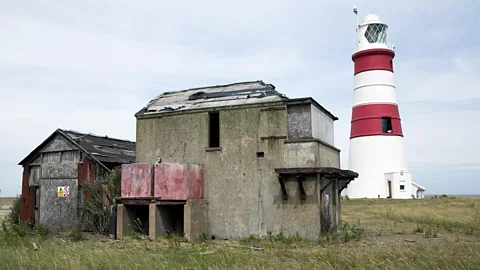 Geography Photos/Getty Images
Geography Photos/Getty ImagesOrford Ness is now one of Britain's most protected natural landscapes. For decades, however, it was the hidden nerve centre of secret military research.
Orford Ness is Britain's answer to Area 51. It may now be abandoned, some of its research still secret, and much of its land too dangerous to walk over, but its past continues to ripple through the country's present and future.
The former top-secret site of Orford Ness is situated on a spit of land about 100 miles (160km) north-east of London on the Suffolk coast. The twisting country roads that take you there make it seem much further, however. When I arrive after a long car journey, it is impossible to tear my eyes away from the triangular rooftops of the disused nuclear weapon laboratories lining the horizon. The need to funnel any explosion upwards gave two of the laboratories their unique pagoda-like shape. All but their roofs are hidden behind a huge earthen wall, which blocks the view of curious onlookers as well as protecting the site from the sea.
The laboratories are separated from the mainland by the river Orford, and for over 100 years visitors have taken the ferry across. Now it's my turn and I join the 150 or so other ticket holders who troop past the easily overlooked, and rather vague, memorial stone to those men and women who crossed the river to "serve their country".
When I clamber off the boat, I quickly lose my sense of space and time. Apart from the wind, it is silent. There are no cars, tea shops or trees. There is little shelter from the sun.
I don't see the ruins of laboratories as I expect, but big sky country: an epic landscape seemingly impossible to fit into this narrow shingle peninsula.
You might also like:
In one direction, marshland stretches to a huge shingle bank where nuclear weapons casings were whirled round in a huge laboratory centrifuge to test their safety. In another, it stretches to a vast bunker-like building with 12 tall transmission masts towering over it. This is all that's left of the huge £500m-£600m ($604m-$725m) – in 2022 money – Cobra Mist over-the-horizon radar system, and that in turn is lost under the wide blue sky. The white dome of Sizewell nuclear power station is visible in the distance.
As my eyes get used to the landscape, I notice the marshland is criss-crossed by lines of concrete supports for security fences that have been taken down. Gates hanging off their hinges. Petrol pumps spilling wires. Electricity power transformers drowning in vegetation.
Further on, I stumble across the Island of Secrets exhibition in the former WW1 officers mess that tells the story of Orford Ness.
The whole of this coastline is awash with history and mystery; there are stories of a failed German invasion, and even of an infamous UFO "encounter" in the nearby Rendlesham Forest in 1985.
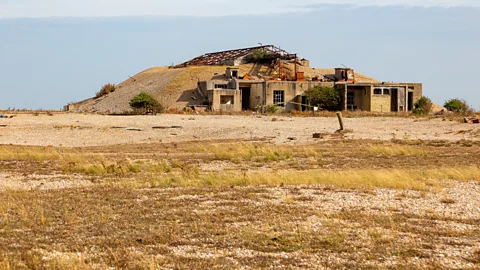 Geography Photos/Getty Images
Geography Photos/Getty Images"There was always something about this coast that was mysterious," says William Walters, a professor of politics in the Department of Political Science at Carleton University, Ottawa, who also studies state secrecy.
Out here, caught up in the landscape of the imagination, it is easy to forget that for much of the 20th Century the area was a hive of activity. The pristine salt marsh contained two hangars whose concrete aprons were once covered in the remnants of Luftwaffe planes that had been captured or shot down before being brought to the Ness for testing. The prize exhibit was a complete Japanese "Zero" fighter. Out on the shingle stood a huge radio aerial that looked like a ray gun.
And men died here. There is no memorial I can see to the Orford Ness test pilots and scientists who gave up their lives in desperate attempts to create war-winning new technologies. The site now may be guarding some new secrets.
Orford Ness is a prehistoric landscape. The largest vegetated shingle spit in Europe stretches for about 10 miles (16km) along the Suffolk coast, and is home to many rare plants and invertebrates. The fragile environment is shaped and reshaped by the power of the sea. The marshes are younger. They date back to the 12th Century and were rarely visited, used for little more than grazing sheep and hunting.
"It's a unique environment that survived because it was inaccessible, barren and dry, and so like other unproductive sites, it wasn't worth exploiting," says Emma Hay, nature conservation adviser at the National Trust, which is a heritage trust with more than five million members.
Ten years after the Wright Brothers first flew in 1903, the British government decided that the Ness would be the site for a new top-secret facility whose job was to work out how best to use aircraft in warfare. Chinese labourers drained the marshes and built the sea wall, and 70 years of top-secret research followed the arrival of the Royal Flying Corps' Armament and Experimental Flying Section in 1915. Its secret history largely ended with departure of the Atomic Weapons Laboratory in 1971 and the sudden closure of Cobra Mist in 1973.
Having helped develop technologies used to win two world wars and deter the Soviet Union in the Cold War, Orford Ness's legacy is still shaping our world today. Its importance is comparable to that of Area 51, the highly classified USAF (United States Air Force) facility in the Nevada desert used to develop and test experimental aircraft.
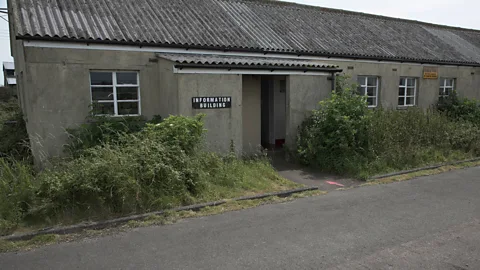 Geography Photos/Getty Images
Geography Photos/Getty ImagesIt has also been compared to Bletchley Park, the centre of Allied codebreaking during WW2.
"We sometimes get people on tours who feel that this site glorifies war and weapons, but we are presenting what happened not whether it was right or wrong," says Glen Pearce, the National Trust's operations manager at Orford Ness. "I often say to them the mobile phone in their hands or the smartwatch on their wrist may have been developed from the work carried out here."
"It is important that people understand what happened at sites like Orford Ness and Bletchley Park and how important they were," says Sue Black, a British computer scientist who was awarded an OBE for her successful Saving Bletchley Park campaign. "So they can celebrate the dedication, hard work and sacrifice of the people who worked there, and their contribution to peace. It helps to keep us grounded and realise what is important in our own lives."
Orford Ness was part of a network of institutions that stretched as far as Australia, including the Royal Aircraft Establishment at Farnborough near London and the Atomic Weapons Research Establishment.
"Orford Ness was rather like a modern-day science park," says David Warren, a member of the Independent Research Group Orford Ness (Irgon), a small group of volunteers who are interested in the military trials that took place at the site. "One government department came in, built something for some trials, and then went home. Then a new department would come in, and either reuse the same buildings, or build something new."
But it was a science park with a difference. It operated on a need-to-know basis. "I would get a basic drawing of a piece of a missile," says a veteran who asked not to be identified. "I obviously knew it was for testing, and I could guess that it was going to hold high explosive, but I didn't know anything else, like its mission. I was never even told if it worked."
Some of the work undertaken at Orford Ness was truly ground-breaking. In the early hours of 17 June 1917, three planes from Orford Ness took off, at least one of which was equipped with some of the first night flying instruments. Their mission was to shoot down the first of a new type of German Zeppelin designed to fly too high for Britain's anti-aircraft guns to hit – and they succeeded. The huge craft crashed in flames on the edge of the Ness.
The scientists at Orford Ness had to answer questions that had rarely been asked before, such as how to avoid stalling and spinning (which claimed the lives of many inexperienced pilots), fly at night, jump out of a plane and live to tell the tale, take-off and land from a ship and shoot down a Zeppelin. Led by talented leaders like Henry Tizard, one of those who helped develop radar and would later become the Ministry of Defence's chief scientific adviser, their answers still define aerial warfare.
 George W Hales/Getty Images
George W Hales/Getty ImagesThese pilots who pushed primitive planes to their limits, and in some cases, died doing so, helped to forge our modern idea of the test pilot.
"These test pilots were incredibly brave, imaginative and resilient," says Pearce. "They were really starting from scratch, inventing new ways to test things and willing to take their chances."
This line of work continued in the next war. In 1939 the German Luftwaffe (air force) seemed to be technologically superior to the Britain's RAF. So, British weapons were tested on captured enemy aircraft and captured weapons on British aircraft to close this gap.
Some tests involved the Incendiary Tower, built to evaluate the impact of bullets into petrol tanks. The data was used to improve the designs of planes and weapons, and to tell RAF fighter pilots which parts of enemy aircraft to target. One engineer joked that he knew so much about German aircraft that he could have applied for a job in the Luftwaffe.
It was dangerous work, and in war time, doubly so. A civilian technician was killed during one such test.
From the 1920s to the 1960s, when the weather was good enough, Orford Ness played host to some of the most important tests in its history, when bombs of all sizes were dropped over the shingle and sea range. The casing of some of the biggest weapons in the British arsenal were tested, including the 12,000lb (5,400kg) Tallboy, or earthquake bomb, developed by famous British engineer Barnes Wallis, and the casing of Blue Danube, Britain's first nuclear bomb. Young women were employed as human computers to calculate the results. A photograph survives of four such women: the self-styled "Gang of Four" of Janet Robinson, Joyce Benynon, Maggie Downer, and Maggie Driver laughing and posing like film stars. At least one of them went on to become a bombing range controller at Orford Ness.
The improvements to bomb ballistics gained by the research at Orford Ness arguably helped the Allies' strategic bombing campaign shorten World War Two. The science of bomb ballistics pioneered at the Ness led indirectly to the smart weapons used today.
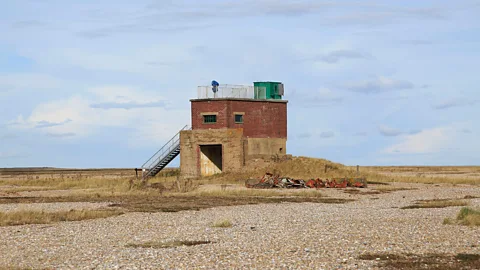 Geography Photos/Getty Images
Geography Photos/Getty ImagesThe isolation of Orford Ness was vital to keeping secret the use of another revolutionary new technology. Radar wasn't new – by 1934 the Germans were using it to improve the accuracy of their artillery – but the British had an entirely new way to use it.
Robert Alexander Watson Watt was a British radar pioneer. On 26 February 1935, near Daventry in England's Midlands, his team had shown that aircraft could be detected by bouncing radio waves off them. It was his work at Orford Ness that would turn principle into practice.
Full-scale trials began in June 1935 and their success led to Chain Home, the chain of early warning radar stations built by the RAF that proved vital in the defeat of the Luftwaffe in the Battle of Britain.
Irgon's research suggests Orford Ness played host to at least three different over-the-horizon radar systems (OTHR), which can detect targets far beyond the range of ordinary radar. The first two were used to detect nuclear tests.
The third such system, the joint US-UK Cobra Mist, was the first such truly operational system in the world, and work began on constructing the huge shell shape site with all its aerials in the late 1960s. This time, its job was to pick up Soviet aircraft and missile activity as far away as Russia's Far North. In 1972, when it began operating, it attracted the attention of more than its fair share of Soviet spy trawlers. Just one year later it was suddenly closed down due to noise interference.
Tests at the site to failed identify the source of the interference. Further experiments provided some evidence that the noise source was on land, and that the possibility it was Soviet countermeasures couldn't be ruled out. The cause of the noise remains unknown to this day. Despite this setback, Western interest in this radar technology has been renewed because of increased tensions with both Russia and China.
There was also much nuclear research carried out on the site.
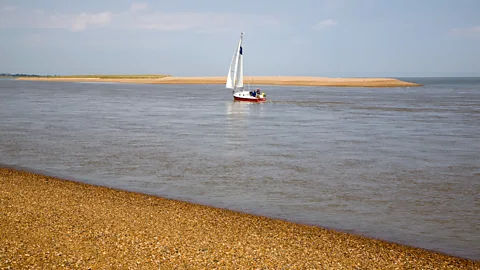 Education Images/Getty Images
Education Images/Getty ImagesIn 1953, the Atomic Weapons Research Establishment (AWRE) chose Orford Ness for its location, and over the next 10 years six unique laboratories were built on the shingle to evaluate the safety of Britain's Blue Danube bomb, and then of further bombs and warheads. Environmental factors like high vibrations, high temperatures and high g-forces were tested on them to ensure they were safe.
This work was vital for the creation of Britain's nuclear deterrence, but defence cuts and the decision to rely on American nuclear technology forced AWRE scientists to turn their skills to commercial projects, including work on Concorde. Then in 1973 the laboratories closed.
Ad hoc tests appear to have continued for another 10 years while unexploded bombs were cleared from the site, and Cobra Mist was converted into a transmission station for the BBC World Service.
In 1993, Orford Ness began a new stage in its life when the National Trust bought the majority of the site. Its main objective was to maintain this internationally significant environment in as natural and wild a state as practicable, which meant the managed ruination of many of its unique buildings. Controversially several buildings were knocked down because they were beyond "authentic repair", and the airfields were cleared of metal and concrete and returned to marshland.
The uniqueness of Orford Ness is now recognised at a UK, European and global level. "Sites don't come more designated than this when it comes to nature conservation," says the National Trust's Emma Hay. "So, it's very special."
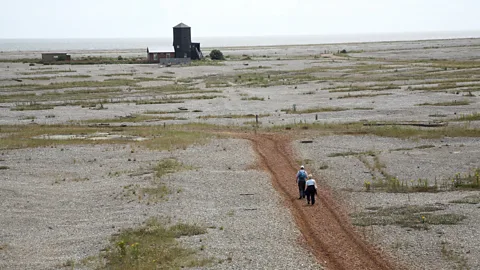 Geography Photos/Getty Images
Geography Photos/Getty ImagesCobra Mist is now owned by locally born corporate lawyer Nicholas Gold, who has been critical of the National Trust's handling of the site, and the radio array, with its 12 transmission masts up to 340ft (100m), is used for telecoms activities by several users.
He hopes to build a solar farm on the site.
In the end, Orford Ness keeps its secrets, large and small, including when the last tests occurred on the site. "We think the last tests were carried out in the early 80s on the Trident missiles in the Pagodas, but information is very scare," says Pearce.
A great deal of the research carried out at Orford Ness is still classified. Many documents were destroyed in a flood in 1947 and the great North Sea flood of 1953. On the evening of 31 January, a terrific gale combined with a spring tide caused massive flooding along the East Coast. Around 300 people were killed, 32,000 people were evacuated from their homes and 1,000 miles (1,609km) of coastline were flooded. The storm destroyed the sea wall on Orford Ness, which had been built by the Chinese labourers, and flood waters inundated the site. As at other top-secret sites, the veterans of Orford Ness are often reluctant to talk about their work even years afterwards.
"There is a sense of foreboding and fear that comes with any thought of breaking the culture of secrecy, or just a strong sense of loyalty and duty," says Walters. "There's also a lot of purposeful ambiguity as well. It's not as though someone's been given a piece of paper that says, after this date you are free to talk about what you did."
"You can just imagine if you kept something secret since you were 18, it's going to be pretty hard to talk about now," says Sue Black.
--
If you liked this story, sign up for the weekly bbc.com features newsletter, called "The Essential List" – a handpicked selection of stories from BBC Future, Culture, Worklife, Travel and Reel delivered to your inbox every Friday.
